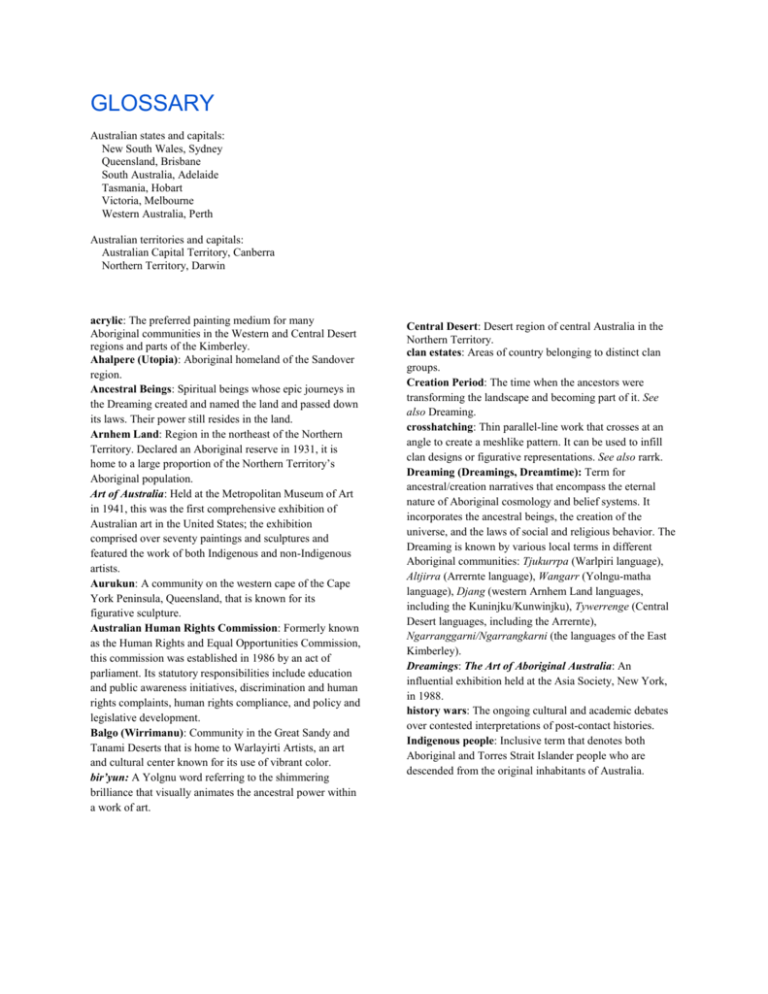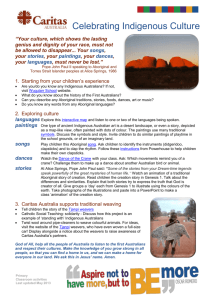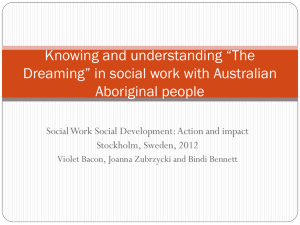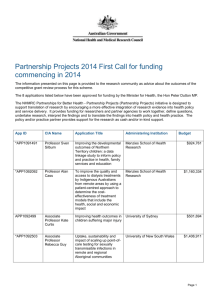Crossing Cultures Glossary
advertisement

GLOSSARY Australian states and capitals: New South Wales, Sydney Queensland, Brisbane South Australia, Adelaide Tasmania, Hobart Victoria, Melbourne Western Australia, Perth Australian territories and capitals: Australian Capital Territory, Canberra Northern Territory, Darwin acrylic: The preferred painting medium for many Aboriginal communities in the Western and Central Desert regions and parts of the Kimberley. Ahalpere (Utopia): Aboriginal homeland of the Sandover region. Ancestral Beings: Spiritual beings whose epic journeys in the Dreaming created and named the land and passed down its laws. Their power still resides in the land. Arnhem Land: Region in the northeast of the Northern Territory. Declared an Aboriginal reserve in 1931, it is home to a large proportion of the Northern Territory’s Aboriginal population. Art of Australia: Held at the Metropolitan Museum of Art in 1941, this was the first comprehensive exhibition of Australian art in the United States; the exhibition comprised over seventy paintings and sculptures and featured the work of both Indigenous and non-Indigenous artists. Aurukun: A community on the western cape of the Cape York Peninsula, Queensland, that is known for its figurative sculpture. Australian Human Rights Commission: Formerly known as the Human Rights and Equal Opportunities Commission, this commission was established in 1986 by an act of parliament. Its statutory responsibilities include education and public awareness initiatives, discrimination and human rights complaints, human rights compliance, and policy and legislative development. Balgo (Wirrimanu): Community in the Great Sandy and Tanami Deserts that is home to Warlayirti Artists, an art and cultural center known for its use of vibrant color. bir’yun: A Yolgnu word referring to the shimmering brilliance that visually animates the ancestral power within a work of art. Central Desert: Desert region of central Australia in the Northern Territory. clan estates: Areas of country belonging to distinct clan groups. Creation Period: The time when the ancestors were transforming the landscape and becoming part of it. See also Dreaming. crosshatching: Thin parallel-line work that crosses at an angle to create a meshlike pattern. It can be used to infill clan designs or figurative representations. See also rarrk. Dreaming (Dreamings, Dreamtime): Term for ancestral/creation narratives that encompass the eternal nature of Aboriginal cosmology and belief systems. It incorporates the ancestral beings, the creation of the universe, and the laws of social and religious behavior. The Dreaming is known by various local terms in different Aboriginal communities: Tjukurrpa (Warlpiri language), Altjirra (Arrernte language), Wangarr (Yolngu-matha language), Djang (western Arnhem Land languages, including the Kuninjku/Kunwinjku), Tywerrenge (Central Desert languages, including the Arrernte), Ngarranggarni/Ngarrangkarni (the languages of the East Kimberley). Dreamings: The Art of Aboriginal Australia: An influential exhibition held at the Asia Society, New York, in 1988. history wars: The ongoing cultural and academic debates over contested interpretations of post-contact histories. Indigenous people: Inclusive term that denotes both Aboriginal and Torres Strait Islander people who are descended from the original inhabitants of Australia. Intervention: Colloquial term for the Northern Territory National Emergency Response Act (2007), a controversial Australian federal government policy to deploy extra police, restrict the sale of alcohol and access to pornography, and suspend government benefits to parents who neglected their children in the Northern Territory. Indigenous leaders and other social commentators have been divided in their support of the legislation, which some see as another paternalistic attempt to control the lives of Aboriginal people and undermine community aspirations of self determination. Land Rights: A political and cultural movement that seeks to enshrine in law the recognition of Aboriginal systems of land ownership that predate colonization. The Northern Territory Land Rights Act (1976) was an important stage of this process. Lockhart River: A community on the eastern cape of Cape York Peninsula, Queensland, that has become known for its youth-driven and individualistic art practice. native title: Form of land title that recognizes Indigenous people from Australia as having certain rights in land that they occupied prior to 1788. Formal federal legislation, including the Native Title Act (1993) and the Native Title Amendment Act (1998), was implemented as a result of the historic Mabo and Wik decisions of the High Court of Australia. See also terra nullius; Mabo decision. National Apology: On behalf of the Australian government and the Australian people, Prime Minister Kevin Rudd formally apologized to Aboriginal and Torres Strait Islander people for the Stolen Generations and past injustices on February 13, 2008. National Sorry Day: An unofficial national day that began in 1998 to recognize the historical mistreatment of Indigenous people. It is held on May 28. ochres: Earth pigments containing iron oxides, used in contemporary and customary painting and body decoration. Ochres are prized for their spiritual associations and as an item of trade. outstation: A small or medium-sized settlement of family and cultural groupings that is situated on traditionally owned land. Papunya Tula Artists: A cooperative of artists formed at Papunya in 1971 with the encouragement of Geoffrey Bardon that gave rise to the Western and Central Desert art movements. rarrk: A Kunwinjku word meaning the overlaying of linear clan designs that are found in bark and body painting in western and central Arnhem Land to invoke ancestral presence. See also crosshatching. Racial Discrimination Act (1975): Landmark statute that overrides all state and territory legislation in making all forms of racial discrimination illegal; affirmed by the High Court of Australia in Koowarta v. Bjelke-Petersen (1982). stringybark tree: A Eucalyptus tree that is prized for its thick, fibrous, and “stringy” bark. It is used by many Indigenous artists in Arnhem Land. Stolen Generations: Term used to refer to Aboriginal and Torres Strait Islander children who were removed from their families by Australian federal and state government agencies and church missions, according to parliamentary acts. terra nullius: Latin meaning “land belonging to no one”; legal concept used as justification for British claims to Aboriginal land/Australia. Tiwi Islands: Located off the Northern Territory coast, the Tiwi Islands (comprising Bathurst and Melville Islands) are home to the Tiwi people, who are culturally and artistically distinct. The islands are also home to three art centers: Munupi Arts and Crafts, Tiwi Design, and Jilamara Arts and Crafts. Warmun: Also known as Turkey Creek, a community in the East Kimberley known for its minimalist paintings on canvas in ochres. Western Desert: A cultural region in Western Australia and the Northern Territory that is home to the school of Western Desert Artists, who primarily use acrylic paints for the visualization of ancestral narratives for the public domain Yuendumu: Indigenous community in the Central Desert region of the Northern Territory created in 1948 and predominantly in habited by Warlpiri people.








